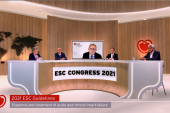IV Iron in HF Misses (Again) in HEART-FID, but Meta-analysis Sees a Role
(UPDATED) Another RCT of ferric carboxymaltose in HFrEF has fallen short. Combined with earlier studies, though, a clearer picture emerges.

AMSTERDAM, the Netherlands—Disappointing many who hoped this large, randomized, double-blind trial would show a clear win, HEART-FID is the latest trial of iron supplementation in heart failure to miss its primary endpoint. Undaunted, experts in the field say they remain convinced ferric carboxymaltose (FCM) is worth considering in HF patients with iron deficiency.
That view is buoyed by a meta-analysis, presented immediately following HEART-FID in this morning’s Hot Line session at the European Society of Cardiology 2023 Congress, by Piotr Ponikowski, MD, PhD (Wroclaw Medical University, Poland). Combining patients from HEART-FID with those from CONFIRM-HF and AFFIRM-AHF, investigators showed that FCM significantly reduced total cardiovascular hospitalizations and cardiovascular death compared with placebo (rate ratio [RR] 0.86; 95% CI 0.75-0.98). A second, co-primary endpoint—total heart failure hospitalizations and cardiovascular death—fell just shy of statistical significance (RR 0.87; 95% CI 0.75-1.01).
Individually, a number of endpoints also favored FCM over placebo, Ponikowski showed. Total CV hospitalizations were a relative 17% lower, total HF hospitalizations 16% lower, and total all-cause hospitalizations were 13% lower.
Prior to HEART-FID was IRONMAN, presented at last year’s American Heart Association 2022 Scientific Sessions. Like AFFIRM-AHF before it, IRONMAN was affected by the COVID-19 lockdowns, with both trials ultimately failing to meet their primary endpoint, although analyses restricted to pre-COVID times pointed to a benefit of iron repletion therapy in reducing HF hospitalizations and cardiovascular death. IRONMAN was not included in today’s meta-analysis, Ponikowski explained, because it was not a double-blind trial; however, in a sensitivity analysis the results are essentially unchanged with the addition of IRONMAN results.
The US Food and Drug Administration is already persuaded by the data to date: earlier this summer the regulator granted a new indication to IV iron in heart failure. Guidelines in both the US and Europe already recommend screening for iron deficiency, while the EU recommendations go one step further to specify that intravenous FCM can be considered to prevent future heart failure admissions in symptomatic patients recently hospitalized.
As Ponikowski pointed out in his presentation, iron deficiency is one of the most common comorbidities in chronic heart failure, plaguing roughly 50% of patients, a number that reaches 70-80% among patients with acutely decompensated heart failure. It is associated with everything from reduced exercise capacity to increased hospitalizations and death.
HEART-FID
Many had hoped that HEART-FID, which is three times larger than IRONMAN, would deliver a conclusive result on the IV iron repletion question. It did not.
As presented by Robert Mentz, MD (Duke University Medical Center, Durham, NC), HEART-FID randomized 3,014 patients to placebo or FCM as two doses of 15 mg/kg given 7 days apart, every 6 months. Both groups got a median of six doses over the course of the study.
It's a very exciting time in the management of patients with HFrEF given the number of oral therapies that we have that improve clinical outcomes, help patients feel better, and have an improved trajectory. Robert Mentz
The primary outcome was a hierarchical endpoint made up of all-cause mortality, total HF hospitalizations, and change in 6-minute walk test.
Fewer FCM-treated patients died over 12 months of follow-up, at a rate of 8.6% versus 10.3%. Among survivors, 332 placebo-treated patients and 297 FCM patients required hospitalizations. Lastly, FCM-treated patients had greater improvements in 6-minute walk test at 6 months, with a mean distance of 8 m versus 4 m. Together, those yielded a P value (Wilcoxon-Mann-Whitney test) of 0.019, which did not meet the FDA-specified P-value threshold of P = 0.01.
In a win ratio analysis, there were 11% more wins in the FCM group, but the overall ratio was 1.10 (99% CI 0.99-1.23). Moreover, a “top secondary endpoint,” for which the trial was sufficiently powered, was time to CV death or first HF hospitalization, and here, too, there were no significant differences between the two groups.
Making Sense of IV Iron
During a press conference, Mentz stressed that all of the individual primary endpoint outcomes in HEART-FID, despite missing statistical significance, “modestly” favored FCM. While the trial itself is “neutral,” he acknowledged, “the totality of evidence with IV FCM from prior studies assessing symptomatic and functional status endpoints, combined with clinical outcomes studies including HEART-FID, show overall safety and clinical benefits of IV FCM in HFrEF with iron deficiency.”
Many HEART-FID patients who had their IV doses at baseline and again at 7 days were found to still be iron replete 6 months later, Mentz noted.
“It's a very exciting time in the management of patients with HFrEF given the number of oral therapies that we have that improve clinical outcomes, help patients feel better, and have an improved trajectory,” he said. Iron repletion, by contrast, “is not another pill that patients need to take every day, but rather it's a straightforward injection that can be given in the hospital or in the clinic.”
Also stressing the totality of the data, Ponikowski concluded that FCM “should be considered to reduce the risk of heart failure and cardiovascular hospital admissions,” adding that the meta-analysis helps to also point the way for future research.
This path includes looking for a “magic biomarker” that would help identify patients most likely to benefit from FCM. He showed data on transferrin saturation (TSAT) suggesting that higher TSAT appears to be associated with a lack of treatment effect, whereas lower TSAT may predict benefit. Clarifying eligibility criteria for optimal redosing also warrants further attention, Ponikowski suggested.
Mixed Reactions
Discussants for HEART-FID and Ponikowski’s meta-analysis seemed similarly underwhelmed by the data, with both observers using the phrase “regression to the truth” to describe the phenomenon whereby more trials and more data haven’t revealed a powerful effect of IV iron on hard endpoints. Scott Solomon, MD (Brigham and Women’s Hospital, Boston, MA), said that it is “hard not to be disappointed” by the HEART-FID results, while Pardeep Jhund, MBChB (University of Glasgow, Scotland), pointed out that this is only the latest in a long series of meta-analyses of IV iron in heart failure, yet even now the treatment’s role in reducing morbidity and mortality outcomes “remains questionable,” he said.
“While the absence of evidence is not evidence of absence, the wide confidence intervals of the treatment effect on total HF hospitalizations and CV death leave a lot of room for doubt about the efficacy of IV iron in reducing HF hospitalizations,” Jhund concluded.
The patients feel better with this therapy. Nancy K. Sweitzer
Nancy K. Sweitzer, MD, PhD (Washington University School of Medicine, St. Louis, MO), commenting on these latest FCM data for TCTMD, saw things differently, arguing that these findings help put the relationship between iron deficiency and heart failure in context. “I think these trials tell us that iron deficiency is definitely not the underlying pathology of heart failure—you don't get heart failure because you're iron deficient. If you have heart failure and you're iron deficient, then your heart failure can be worse, and in some patients that may lead to hospitalization and even hasten death,” she said. “Iron deficiency is a marker of disease severity. It is not the cause of heart failure, and I think we're all comfortable with that.”
On that background, she continued, it’s not surprising that iron repletion didn’t lead to better survival—that doesn’t mean it’s not important. “The trials have shown us quite clearly that treatment of iron deficiency improves how patients feel, it improves their exercise capacity. And for me as a clinician, I want to do that.”
As such, it’s also important that HEART-FID showed FCM to be very safe—no differences in treatment-emergent adverse events were seen between the iron and placebo groups. And while all of the trials point to IV iron as being beneficial across each of the single and composite endpoints studied, the key is that iron, as an IV formulation, is helping patients.
“The patients feel better with this therapy,” Sweitzer said. “In my practice, I check for iron deficiency in every new patient and in every hospitalized patient. And when they are iron deficient, I give them IV iron.”
Shelley Wood was the Editor-in-Chief of TCTMD and the Editorial Director at the Cardiovascular Research Foundation (CRF) from October 2015…
Read Full BioSources
Mentz RJ, Garg J, Rockhold FW, et al. Ferric carboxymaltose in heart failure with iron deficiency. N Engl J Med. 2023;Epub ahead of print.
Ponikowsi P. Effects of FCM on recurrent HF hospitalizations: an individual participant data meta-analysis. Presented at: ESC 2023. August 25, 2023. Amsterdam, the Netherlands.
Disclosures
- Mentz reports research contracts with American Regent, and consulting/royalties/owner/stock options in Vifor Pharmacosmos and American Regent.
- Ponikowski reports receiving consulting fees and speakers honoraria from Vifor Pharma, Boehringer Ingelheim, AstraZeneca, Servier, Novartis, Bayer, MSD, Pfizer, Moderna, Sanofi, and Radcliffe Group, as well as research grants from Vifor Pharma.





Comments